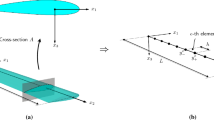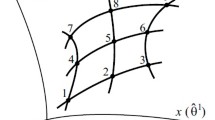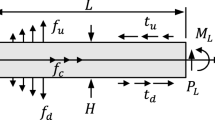Abstract
The discretization by finite elements of a model variational problem for a clamped loaded beam is studied with emphasis on the effect of the beam thickness, which appears as a parameter in the problem, on the accuracy. It is shown that the approximation achieved by a standard finite element method degenerates for thin beams. In contrast a large family of mixed finite element methods are shown to yield quasioptimal approximation independent of the thickness parameter. The most useful of these methods may be realized by replacing the integrals appearing in the stiffness matrix of the standard method by Gauss quadratures.
Similar content being viewed by others
References
Babuška, I., Aziz, A.K.: Survey lectures on the finite element method. In: The mathematical foundations of the finite element method with applications to partial differential equations (A.K. Aziz, ed.), pp. 5–359. New York: Academic Press 1973
Bercovier, M.: Perturbation of mixed variational problems. Application to mixed finite element methods. Rev. Française Automat. Informat. Recherche Opérationnelle Sér. Rouge Anal. Numér.12, 211–236 (1978)
Brezzi, F.: On the existence, uniqueness and approximation of saddle point problems arising from Lagrangian multipliers. Rev. Française Automat. Informat. Recherche Opérationnelle8 R-2, 129–151 (1974)
Falk, R., Osborn, J.: Error estimates for mixed methods. Rev. Française Automat. Informat. Recherche Opérationnelle Sér. Rouge Anal. Numér. (in press 1981)
Fried, I.: Finite element analysis of incompressible material by residual energy balancing. Internat. J. Solids and Structures10, 993–1002 (1974)
Hughes, T.J.R., Cohen, M., Haroun, M.: Reduced and selective integration techniques in the finite element analysis of plates. Nuclear Engrg. Design46, 203–222 (1978)
Hughes, T.J.R., Taylor, R.L., Kanoknukulchai, W.: A simple and efficient finite element for plate bending. Internat. J. Numer. Methods Engrg.11, 1529–1543 (1977)
Malkus, D.S., Hughes, T.J.R.: Mixed finite element methods-reduced and selective integration techniques: a unification of concepts. Comput. Methods Appl. Mech. Engrg.15, 63–81 (1978)
Pawsey, S.F., Clough, R.W.: Improved numerical integration of thick shell finite elements. Internat. J. Numer. Methods Engrg.3, 545–586 (1971)
Pugh, E.D.L., Hinton, E., Zienkiewicz, O.C.: A study of quadrilateral plate bending elements with reduced integration. Internat. J. Numer. Methods Engrg.12, 1059–1079 (1978)
Timoshenko, S.P.: On the correction for shear of the differential equation for transverse vibrations of prismatic bars. Philos. Mag. Ser.6, 41, 744–746 (1921)
Zienkiewicz, O.C., Hinton, E.: Reduced integration, function smoothing and non-conformity in finite element analysis (with special reference to thick plates). J. Franklin Inst.302, 443–461 (1976)
Zienkiewicz, O.C., Taylor, R.L., Too, J.M.: Reduced integration techniques in general analysis of plates and shells. Internat. J. Numer. Methods Engrg.5, 275–290 (1971)
Author information
Authors and Affiliations
Rights and permissions
About this article
Cite this article
Arnold, D.N. Discretization by finite elements of a model parameter dependent problem. Numer. Math. 37, 405–421 (1981). https://doi.org/10.1007/BF01400318
Received:
Issue Date:
DOI: https://doi.org/10.1007/BF01400318




